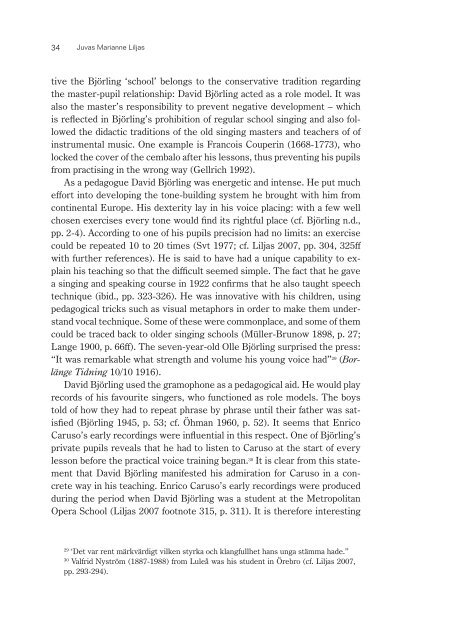Opera on the Move in the Nordic Countries during the Long 19th ...
Opera on the Move in the Nordic Countries during the Long 19th ...
Opera on the Move in the Nordic Countries during the Long 19th ...
You also want an ePaper? Increase the reach of your titles
YUMPU automatically turns print PDFs into web optimized ePapers that Google loves.
34 Juvas Marianne Liljas<br />
tive <strong>the</strong> Björl<strong>in</strong>g ‘school’ bel<strong>on</strong>gs to <strong>the</strong> c<strong>on</strong>servative traditi<strong>on</strong> regard<strong>in</strong>g<br />
<strong>the</strong> master-pupil relati<strong>on</strong>ship: David Björl<strong>in</strong>g acted as a role model. It was<br />
also <strong>the</strong> master’s resp<strong>on</strong>sibility to prevent negative development – which<br />
is reflected <strong>in</strong> Björl<strong>in</strong>g’s prohibiti<strong>on</strong> of regular school s<strong>in</strong>g<strong>in</strong>g and also followed<br />
<strong>the</strong> didactic traditi<strong>on</strong>s of <strong>the</strong> old s<strong>in</strong>g<strong>in</strong>g masters and teachers of of<br />
<strong>in</strong>strumental music. One example is Francois Couper<strong>in</strong> (1668-1773), who<br />
locked <strong>the</strong> cover of <strong>the</strong> cembalo after his less<strong>on</strong>s, thus prevent<strong>in</strong>g his pupils<br />
from practis<strong>in</strong>g <strong>in</strong> <strong>the</strong> wr<strong>on</strong>g way (Gellrich 1992).<br />
As a pedagogue David Björl<strong>in</strong>g was energetic and <strong>in</strong>tense. He put much<br />
effort <strong>in</strong>to develop<strong>in</strong>g <strong>the</strong> t<strong>on</strong>e-build<strong>in</strong>g system he brought with him from<br />
c<strong>on</strong>t<strong>in</strong>ental Europe. His dexterity lay <strong>in</strong> his voice plac<strong>in</strong>g: with a few well<br />
chosen exercises every t<strong>on</strong>e would f<strong>in</strong>d its rightful place (cf. Björl<strong>in</strong>g n.d.,<br />
pp. 2-4). Accord<strong>in</strong>g to <strong>on</strong>e of his pupils precisi<strong>on</strong> had no limits: an exercise<br />
could be repeated 10 to 20 times (Svt 1977; cf. Liljas 2007, pp. 304, 325ff<br />
with fur<strong>the</strong>r references). He is said to have had a unique capability to expla<strong>in</strong><br />
his teach<strong>in</strong>g so that <strong>the</strong> difficult seemed simple. The fact that he gave<br />
a s<strong>in</strong>g<strong>in</strong>g and speak<strong>in</strong>g course <strong>in</strong> 1922 c<strong>on</strong>firms that he also taught speech<br />
technique (ibid., pp. 323-326). He was <strong>in</strong>novative with his children, us<strong>in</strong>g<br />
pedagogical tricks such as visual metaphors <strong>in</strong> order to make <strong>the</strong>m understand<br />
vocal technique. Some of <strong>the</strong>se were comm<strong>on</strong>place, and some of <strong>the</strong>m<br />
could be traced back to older s<strong>in</strong>g<strong>in</strong>g schools (Müller-Brunow 1898, p. 27;<br />
Lange 1900, p. 66ff). The seven-year-old Olle Björl<strong>in</strong>g surprised <strong>the</strong> press:<br />
“It was remarkable what strength and volume his young voice had” 29 (Borlänge<br />
Tidn<strong>in</strong>g 10/10 1916).<br />
David Björl<strong>in</strong>g used <strong>the</strong> gramoph<strong>on</strong>e as a pedagogical aid. He would play<br />
records of his favourite s<strong>in</strong>gers, who functi<strong>on</strong>ed as role models. The boys<br />
told of how <strong>the</strong>y had to repeat phrase by phrase until <strong>the</strong>ir fa<strong>the</strong>r was satisfied<br />
(Björl<strong>in</strong>g 1945, p. 53; cf. Öhman 1960, p. 52). It seems that Enrico<br />
Caruso’s early record<strong>in</strong>gs were <strong>in</strong>fluential <strong>in</strong> this respect. One of Björl<strong>in</strong>g’s<br />
private pupils reveals that he had to listen to Caruso at <strong>the</strong> start of every<br />
less<strong>on</strong> before <strong>the</strong> practical voice tra<strong>in</strong><strong>in</strong>g began. 30 It is clear from this statement<br />
that David Björl<strong>in</strong>g manifested his admirati<strong>on</strong> for Caruso <strong>in</strong> a c<strong>on</strong>crete<br />
way <strong>in</strong> his teach<strong>in</strong>g. Enrico Caruso’s early record<strong>in</strong>gs were produced<br />
dur<strong>in</strong>g <strong>the</strong> period when David Björl<strong>in</strong>g was a student at <strong>the</strong> Metropolitan<br />
<str<strong>on</strong>g>Opera</str<strong>on</strong>g> School (Liljas 2007 footnote 315, p. 311). It is <strong>the</strong>refore <strong>in</strong>terest<strong>in</strong>g<br />
29 ‘Det var rent märkvärdigt vilken styrka och klangfullhet hans unga stämma hade.”<br />
30 Valfrid Nyström (1887-1988) from Luleå was his student <strong>in</strong> Örebro (cf. Liljas 2007,<br />
pp. 293-294).
















